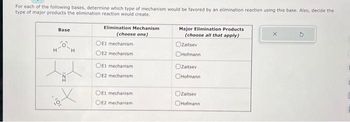
Chemistry
10th Edition
ISBN: 9781305957404
Author: Steven S. Zumdahl, Susan A. Zumdahl, Donald J. DeCoste
Publisher: Cengage Learning
expand_more
expand_more
format_list_bulleted
Question

Transcribed Image Text:For each of the following bases, determine which type of mechanism would be favored by an elimination reaction using this base. Also, decide the
type of major products the elimination reaction would create.
H
Base
ZI
H
X
Elimination Mechanism
(choose one)
OE1 mechanism
OE2 mechanism
OE1 mechanism
OE2 mechanism
OE1 mechanism
OE2 mechanism
Major Elimination Products
(choose all that apply)
Ozaitsev
OHofmann
Zaitsev
OHofmann
OZaitsev
Hofmann
C
Expert Solution
This question has been solved!
Explore an expertly crafted, step-by-step solution for a thorough understanding of key concepts.
This is a popular solution
Trending nowThis is a popular solution!
Step by stepSolved in 3 steps with 3 images

Knowledge Booster
Learn more about
Need a deep-dive on the concept behind this application? Look no further. Learn more about this topic, chemistry and related others by exploring similar questions and additional content below.Similar questions
- The following reaction Reactants⟶Product has a positive ΔG value. Select all the true statements from the list below Group of answer choices The reaction is exergonic The reaction in endergonic The reaction is favorable The reaction is unfavorable The free energy associated with the product is lower than that of the reactants The free energy associated with the product is higher than that of the reactantsarrow_forwardFor the given SN2 reaction, draw the organic and inorganic products of the reaction, and identify the nucleophile, substrate, and leaving group. H -NH₂ H Organic product + Inorganic product H organic product inorganic product Select Draw Rings More Erase Select Draw Rings More Erase с / с H N 1 Q2 Q Select the statement that properly identifies the nucleophile, substrate, and leaving group. CH₂I is the substrate, NH₂ is the nucleophile, and I is the leaving group. O NH₂ is the substrate, CH₂I is the nucleophile, and I¯ is the leaving group. Or is the substrate, NH₂ is the nucleophile, and CH₂I is the leaving group. G H N I Q2 Qarrow_forwardThe S 1 mechanism starts with the rate-determining step which is the dissociation of the alkyl halide into a carbocation and a halide ion. The next step is the rapid reaction of the carbocation intermediate with the nucleophile; this step, completes the nucleophilic substitution stage. The step that follows the nucleophilic substitution is a fast acid-base reaction. The nucleophile now acts as a base to remove the proton from the oxonium ion from the previous step, to give the observed product. Draw a curved arrow mechanism for the reaction, adding steps as necessary. Be sure to include all nonzero formal charges. Draw or edit atoms, groups, or bonds Add/Remove step 2 9 Click and drag to start drawing a structure. alearrow_forward
- Which mechanism does the following reaction fall into? CI 1) NaNH2, NH3 (liq) 2) H3O+ SNAr (sometimes called addition-elimination) None of the given options Electrophilic aromatic substitution O Elimination-addition NH₂arrow_forwardHelparrow_forwardPlease show detailed structure with single atomsarrow_forward
- Draw all of the steps of the mechanism for this reaction. You do not need to show curved arrows for the step involving Mg metal. os Br OCH₂ Mg Et₂0 "MgBr "OCH3arrow_forward4. please help me ♡ Identify the major and minor products for the E2 reaction that occurs when each of the following substrates is treated with a strong base: C Br Minor product Minor product There is no minor product formed. Major product 3 Major product Ćarrow_forwardPropose the major product for each of the following reactions and propose a reaction mechanism for the reactions they present. Dr. explained that he wants reaction products and a reaction mechanism but I don't understand how to do it, I am only in my 1st semester, I hope you can help me.arrow_forward
- Propose a mechanism and predict the products for each reaction. For reactions where more then one product can form, draw all possible products and predict which would be the major product.arrow_forwardThe epoxide shown below can form two different products depending on which reaction condition is used. What are the products of each of these reactions? BRIEFLY explain why you get different products depending on the reaction conditions. By far, the easiest way to do this is to show the mechanism for the key step in each reaction and clearly explain this step. HCH₂CH3 CH3 D н’ CH3OHarrow_forward
arrow_back_ios
arrow_forward_ios
Recommended textbooks for you
 ChemistryChemistryISBN:9781305957404Author:Steven S. Zumdahl, Susan A. Zumdahl, Donald J. DeCostePublisher:Cengage Learning
ChemistryChemistryISBN:9781305957404Author:Steven S. Zumdahl, Susan A. Zumdahl, Donald J. DeCostePublisher:Cengage Learning ChemistryChemistryISBN:9781259911156Author:Raymond Chang Dr., Jason Overby ProfessorPublisher:McGraw-Hill Education
ChemistryChemistryISBN:9781259911156Author:Raymond Chang Dr., Jason Overby ProfessorPublisher:McGraw-Hill Education Principles of Instrumental AnalysisChemistryISBN:9781305577213Author:Douglas A. Skoog, F. James Holler, Stanley R. CrouchPublisher:Cengage Learning
Principles of Instrumental AnalysisChemistryISBN:9781305577213Author:Douglas A. Skoog, F. James Holler, Stanley R. CrouchPublisher:Cengage Learning Organic ChemistryChemistryISBN:9780078021558Author:Janice Gorzynski Smith Dr.Publisher:McGraw-Hill Education
Organic ChemistryChemistryISBN:9780078021558Author:Janice Gorzynski Smith Dr.Publisher:McGraw-Hill Education Chemistry: Principles and ReactionsChemistryISBN:9781305079373Author:William L. Masterton, Cecile N. HurleyPublisher:Cengage Learning
Chemistry: Principles and ReactionsChemistryISBN:9781305079373Author:William L. Masterton, Cecile N. HurleyPublisher:Cengage Learning Elementary Principles of Chemical Processes, Bind...ChemistryISBN:9781118431221Author:Richard M. Felder, Ronald W. Rousseau, Lisa G. BullardPublisher:WILEY
Elementary Principles of Chemical Processes, Bind...ChemistryISBN:9781118431221Author:Richard M. Felder, Ronald W. Rousseau, Lisa G. BullardPublisher:WILEY

Chemistry
Chemistry
ISBN:9781305957404
Author:Steven S. Zumdahl, Susan A. Zumdahl, Donald J. DeCoste
Publisher:Cengage Learning

Chemistry
Chemistry
ISBN:9781259911156
Author:Raymond Chang Dr., Jason Overby Professor
Publisher:McGraw-Hill Education

Principles of Instrumental Analysis
Chemistry
ISBN:9781305577213
Author:Douglas A. Skoog, F. James Holler, Stanley R. Crouch
Publisher:Cengage Learning

Organic Chemistry
Chemistry
ISBN:9780078021558
Author:Janice Gorzynski Smith Dr.
Publisher:McGraw-Hill Education

Chemistry: Principles and Reactions
Chemistry
ISBN:9781305079373
Author:William L. Masterton, Cecile N. Hurley
Publisher:Cengage Learning

Elementary Principles of Chemical Processes, Bind...
Chemistry
ISBN:9781118431221
Author:Richard M. Felder, Ronald W. Rousseau, Lisa G. Bullard
Publisher:WILEY